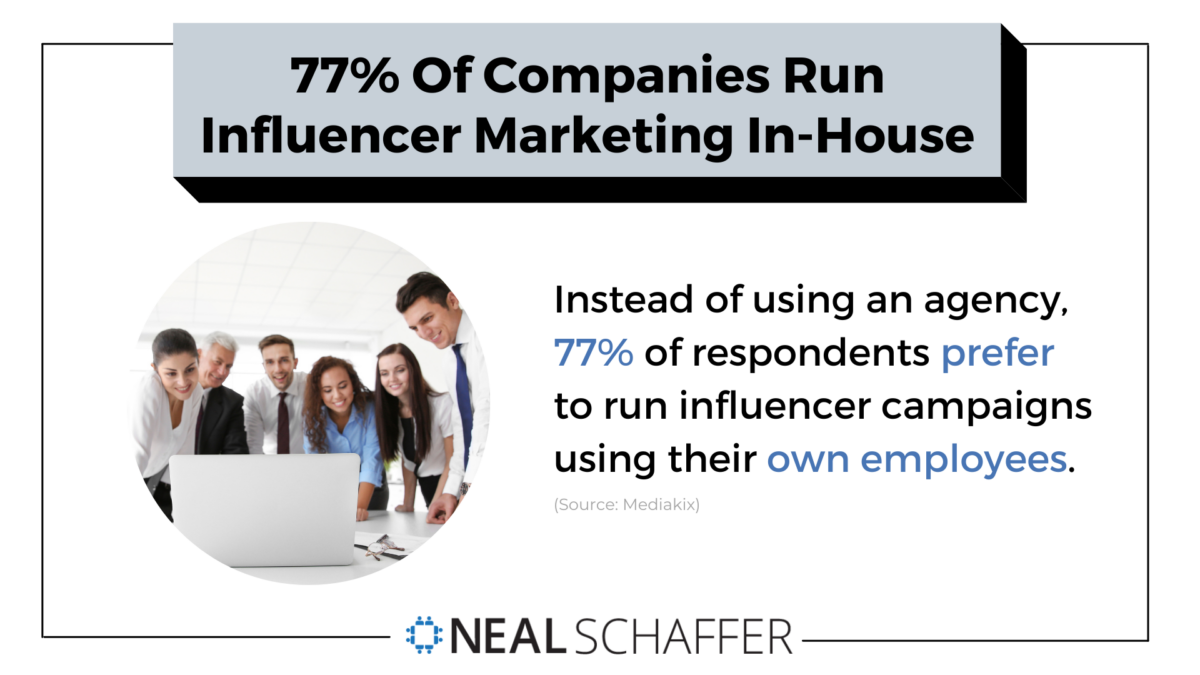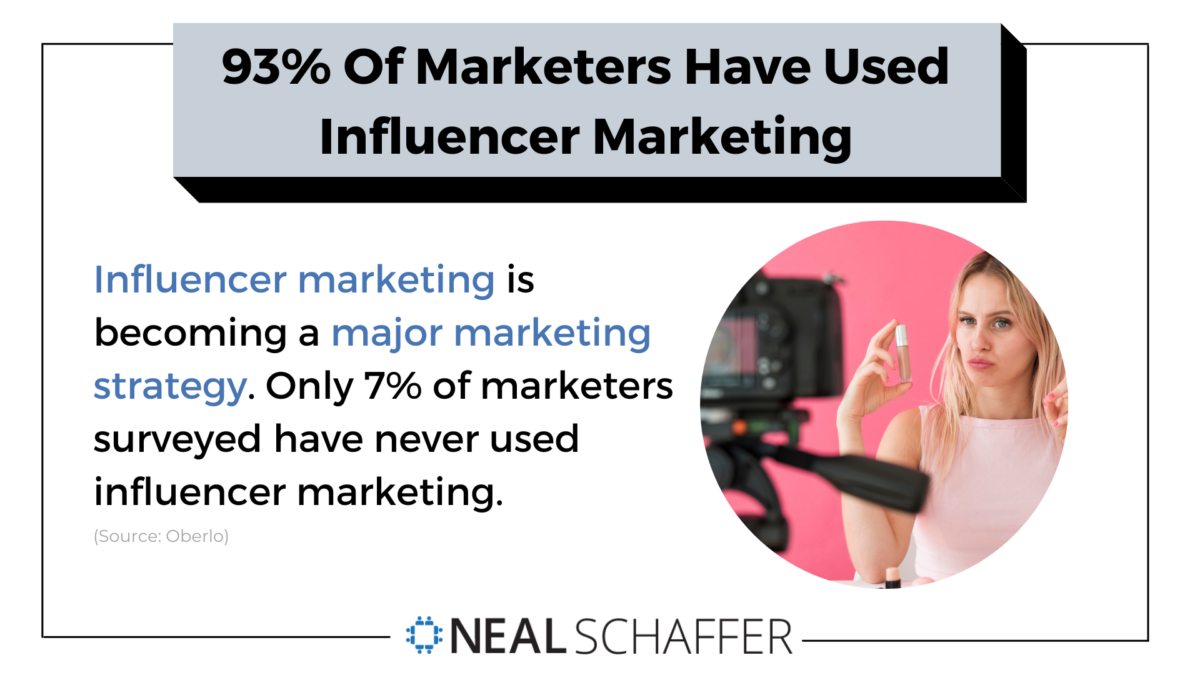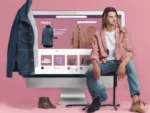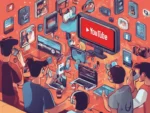Influencer marketing has evolved into one of the most powerful tools in the digital marketing arsenal, delivering impressive ROI for brands across industries. If you’re looking to harness this power, the definitive book on influencer marketing that I wrote, The Age of Influence, is your guide to success. But sometimes, seeing is believing—and the numbers behind influencer marketing tell a compelling story.
In this post, we’ll dive into the statistics that highlight the undeniable value of influencer marketing.
While it may seem like a new trend, influencer marketing has roots that stretch back to the era of celebrity endorsements. However, today’s influencer marketing is about leveraging everyday people—YouTube creators, TikTok stars, Instagram personalities, food bloggers, fitness enthusiasts, and even ordinary housewives—who connect with their audiences on a personal level through social media. These social media influencers, whether they have massive followings or are part of the growing micro and nano-influencer segments, are reshaping how products are marketed and sold.
With this understanding of what influencer marketing truly entails, we’ll explore the latest statistics that can help you refine your strategy and maximize your ROI. While many blogs cover similar data, this post zeroes in on the numbers that matter most for driving results in one of today’s most effective marketing channels.
Let’s dive in!
Influencer marketing is growing
Like so many new technologies or techniques, the influencer marketing trend has grown rapidly as more and more businesses embrace its use. Along with the wider adoption of this technique, budgets are increasing. Here’s how it breaks down statistically:
1. 66% of brands are expected to increase their influencer marketing budgets.
From this, we can see two things: marketers are seeing the value of influencer marketing, and they are getting more confident in its use. Even with money lost on fraudulent influencers, which I will discuss further below, there’s a lot of benefit in this modality.
An industry benchmark report showed that:
2. Almost half of respondents will spend 20% or more of their budget on this type of marketing next year.
For such a new area of marketing, this is a pretty incredible amount of money. Of course they aren’t putting all their eggs in one basket by any means, but this percentage shows confidence. After all, it’s a lot of money to spend on something if it doesn’t work out.
This same survey shows us:
3. 77% of respondents said that they run influencer campaigns with their own employees, instead of using an agency.

I think that one reason for this might be the worry that middlemen are more likely to fall for fraudulent influencers. That’s especially relevant because agencies may have a reputation to protect, but they make their money after placements are made. The good ones will protect their reputation, but corrupt agencies can easily be used as a tool to help the fraudsters. As always, buyer beware.
Lastly, one survey reported that
4. Influencer marketing is so mainstream that 93% of marketers have used it.

We can see that whether marketers use a lot of influencers or not, they are at least giving the technique a try. Depending on the industry (and your marketing goals), influencer marketing is on course to be one of the biggest innovations in recent marketing history.
In fact, it is quickly becoming a must-have line item on marketing budgets regardless of industry.
Influencer marketing is becoming a major market segment
No matter what kind of business you’re promoting, there’s always the opportunity to try and “edge out the competition.” After all, there are a lot of people who can take your potential customer’s money if you don’t. Perhaps the biggest advantage of using influencers is that you have the opportunity to choose people who are part of your target market, or who appeal to your target market. For example, if you’re trying to sell construction materials, having an influencer who is a general contractor might be advantageous. Selling beauty products aimed at the younger market? Pick an influencer who is the same age. Is your client a home improvement company? Testimonials from influential local homeowners might be a good choice.
The usefulness of this method of marketing is a good reason why:
5. Influencer marketing spend in 2022 will reach $15 billion.
This is up from a paltry $2.5 billion estimated to have been spent in 2020.
6. Globally, marketers are expected to spend more than $32 billion on influencer marketing in 2025.

That’s some pretty significant growth!
Influencer marketing has a high ROI
Admittedly, measuring ROI for influencer marketing is a bit more difficult than some other methods. After all, it’s sometimes challenging to know when a purchase is linked specifically to a particular influencer campaign. Some ways of doing this include placing links within the influencer-produced or promoted content, influencer-specific discount codes (often used together with affiliate marketing), customer surveys, and tracking customer engagement with the content.
Now that we’ve discussed the “how,” here’s the “what:”
Is Your LinkedIn Working?
Just released: my new book to help professionals, entrepreneurs, and business owners maximize LinkedIn for real growth.
With years of LinkedIn expertise, Maximizing LinkedIn for Business Growth offers actionable steps to build your brand, expand your network, and drive results.
Start leveraging LinkedIn like never before—grab your copy now! Click the cover or button below to buy on Amazon.
7. In one study, influencer marketing achieved 11x the ROI than banner ads.

This Convince and Convert study involved a food brand, and they used influencers such as food bloggers to reach their audience.
An Influencer Marketing Hub study shows that:
8. On average, businesses earn $5.78 for every dollar spent on influencer marketing.

This represents a large swing in ROI, however, since the best campaigns can generate $20 for that same dollar, and the worst ones break even or even lost you money when not executed correctly. It’s fair to say that proper planning of the campaign is essential to its success.
9. Businesses can generate as much as $18 of earned media value for every dollar invested
This speaks to the brand awareness value that working with influencers has. Since the marketing funnel begins here, even if the other stats don’t convince you, you should start with a brand awareness campaign and compare how your influencers compare in terms of impressions and earned media value with your traditional advertising.
Regardless of how you measure ROI, marketers generally agree that this modality performs well, which is why
10. 89% of marketers say that influencer marketing achieves an ROI at least as good as other methods.

Keep in mind that marketers are counting more than just the value of immediate monetary sales. Instead, they’re including the value of positive publicity, brand recognition, and other less “tangible” benefits of getting influencer endorsements.
Young consumers love influencer marketing
With all this fraud, it’s easy to wonder if influencer marketing is even worth it. I’d like to say it is worthwhile, especially because of its popularity with the millennial generation and younger. One thing that this population loves is hearing from people who are just like them. They love to do research prior to purchasing anything, and like to know that a brand matches their values.
Here’s the breakdown of influencer statistics for younger consumers. According to a Google study:
11. 40% of millennials feel that social media influencers know them better than their friends.

Google also found that
12. 70% of teens on YouTube trust content creators on YouTube more than celebrities.

Together, these statistics form an interesting point. Celebrities are increasingly considered out of touch. After all, they seem to always be chasing money and notoriety. Most social media influencers don’t do this: they’re just like the boy or girl next door. They don’t seem interested in the “latest thing” so much as the “right thing for them.” And when it comes to knowing their audience better than friends, it makes sense to consider how influencers make their money: by knowing their audience. How else are they going to build that following? By not listening? No, an influencer’s “brand” depends on their ability to listen.
Consumers love influencers, too.
There’s no question that influencer marketing has a “young and hip” image. In fact, say the phrase “influencer marketing,” and you’ll automatically think of young people showing off their stuff, or talking about the latest fashion. But older, higher-earning customers love influencers too.
In fact:
13. 80% of people surveyed admit to buying something based off of seeing a recommendation from an influencer.

With an increasing number of digital natives becoming consumers and the pre-Internet demographic aging, the influence that social media – and influencers – have on our purchasing decisions has grown and will continue to grow as more Gen Z become mainstream consumers.
14. 49% of customers depend on influencer recommendations.
That 49% may not include too many of the oldest consumers, but it sure indicates that influencer marketing has pull across many segments of the population.
However, influencers have a longer reach than just those who “depend” on them. In fact:
15. 75% of consumers trust recommendations they see on social media, including both influencers and their social circles.
Getting recommendations from family and friends, of course, isn’t new. How many times have people moved from one town to another and collected recommendations for a barber, beauty salon, or reputable car repair shop? Think of influencers as another segment of this phenomenon, only they don’t know the person they’re recommending things for, and they aren’t bound by geographic location.
Influencer marketing works for business, too.
I don’t want to ignore my business readers. In fact, B2B selling is becoming more and more influencer-based. Granted, this type of marketing doesn’t involve the shiny pictures as much, but input from influencers is still critical.
Consider this statistic from IDC:
16. Among C-level employees and Vice Presidents surveyed, 84% use social media to guide decisions.
What this means is that the same social media that is influencing Gen Z and consumers is also influencing decision makers. While the influencers in the B2B space will be different than in B2C, influencer marketing works equally in both types of industries.
Here is some more data about the role that social media and peer recommendations made online can have on B2B purchase decision-making:
17. 46% of respondents consider colleagues and peers to be their most important sources of information for B2B purchases. Only 24% said this of industry newsletters.
This is an interesting finding, considering that industry newsletters are one of the older ways of distributing product reviews. Then again, any type of print media nowadays relies heavily on advertising revenue. Also, colleagues and peers are the ones who actually use these products.
The same study also found that:
18. 92% of respondents find peer reviews and user feedback to be the most credible purchase guidance.
In some ways, this sounds like what statistics are saying about young consumers feeling influences know better than celebrities. This sort of content is often written after a product has been installed and used for a period of time, by people who know all about customer pain points.
With that said, don’t count out case studies:
19. 47% said that case studies are the most valuable influencer content.
Keep in mind, this is often the business equivalent of sending out a sample, or it can involve bragging about great results when an influencer uses the product with a client. Either way, you’re looking at real-world usage here, and not just laboratory results or some construct of what the company wants you to believe.
Further Reading: B2B Influencer Marketing: The Definitive Guide of 9 Campaign Types and 20 Examples
Influencer Marketing Statistics for Different Social Networks
Influencer marketing will work different for different companies based on the unique demographics and functionality of each social network. These statistics will help you invest wisely where your target audience is.
This is the same principle we use when choosing which print publications to advertise in, the websites to choose, and the part of town to place a billboard in. No matter which advertising modalities we choose, it’s never going to be highly effective if the wrong forum is chosen. Would you really place a makeup advertisement in a woodworking magazine? Probably not. Luckily, the statistics give us some hints on where to concentrate.
TikTok
TikTok’s emergence as a major social media platform can only mean that more influencer marketing budget will flow into it. This has already started to happen:
20. TikTok will soon become the 3rd most popular social media channel for influencer marketing
While Facebook and especially Instagram is where a majority of influencer marketing budgets go, TikTok will soon surpass YouTube influencer marketing because of its growing popularity.
21. TikTok influencers have the highest engagement rates of social media influencers

For instance, engagement rates for micro-influencers on TikTok are near 18% while their Instagram counterparts are lucky to get 4%. Even mega-influencers outperform their counterparts on TikTok, receiving an engagement rate close to 5% versus a paltry 1.2% on Instagram. No wonder why so much marketing budget is flowing to TikTok influencer marketing.
Further Reading: TikTok Influencer Marketing: The Complete Guide to Get You Started
While TikTok grows, from an influencer marketing perspective, Instagram is still king.
22. 79% of brands use Instagram for influencer marketing

This stat speaks to the dominance that Instagram has had in influencer marketing.
23. The most important social media platform for influencer marketing for 97% of marketers is Instagram

This stat really says it all. Not only are brands using Instagram for influencer marketing, but those that do are seeing impressive enough results that it has become their preferred platform.
In addition, Instagram is a very popular platform that appeals to most audiences. As a result, Instagram is a safe bet for at least some of your influencer marketing efforts.
Further Reading: Instagram Influencer Marketing: The Complete Guide
Another study on which social media networks are the most important for influencer marketing revealed that Facebook is still important for influencer marketing. While Instagram comes in first place,
24. Facebook is rated as an important channel for influencer marketing by 45% of marketers and Twitter by 33%
In a nutshell, this statistic means that even though Instagram is important, Facebook should not be ignored. They have the largest number of users among Western social networks. As a result, you can reach just about any demographic by advertising here. As an added benefit, influencer marketing allows you to save money over the cost of paid social. Using both strategies increases your overall ROI.
Further Reading: Facebook Influencer Marketing: Your Guide to Leveraging Influencers on the World’s Largest Social Media Network
Twitter did a user study a while back that indicated the effectiveness of Twitter influencer marketing. In particular, they found that:
25. Almost 40% of Twitter Users admitted to buying something because of an influencer’s Tweeting about it.
Twitter has gone in and out of favor in terms of active users, but that doesn’t mean it isn’t a powerful method of influence. In fact, Twitter’s importance as a news source means that it should remain relevant for a long time to come. Additionally, there are users on Twitter who don’t use other social media platforms. Of course, they’re also a great place to distribute content from your website and others.
Further Reading: Twitter Influencers: How to Find and Connect with Them
Snapchat
Snapchat is still a major social network, but not for influencer marketing:
26. Snapchat is the least popular social media platform for influencer marketing.
Of course, that isn’t to say you shouldn’t use it either. Snapchat is a relatively niche network due to its younger user base. Which brings me back to the advice about which network to pick: follow your audience. If your intended audience is the Snapchat demographic, then you probably should be advertising here. However, selling senior care products or hearing aids on Snapchat is probably not going to get a good ROI. Most Snapchat users are sufficiently young that they don’t care for parents yet, much less need them personally.
Influencer Marketing Statistics That Reveal Best Practices
These statistics speak to the best practices that businesses should be following when it comes to influencer marketing. While there are only two stats here to mention, understanding and implementing them is the key to getting the highest return possible for your influencer marketing investment:
27. Nano influencers have a 5% engagement rate, which is higher than mega – influencers with millions of followers.

Studies have shown that the smaller follower count an influencer has (nano and micro influencer vs. mega influencers) the greater percentage of engagement that an influencer post will receive. There are many reasons for this, one being that the less followers one has, the less chance that they are one in a growing number of fake influencers. Regardless, because nano influencers tend to be more niche in their content and have deeper relationships with their audience, more and more influencer programs are spending more of their budget on influencer marketing with these types of influencers.
28. 60% of marketers believe influencer-generated content performed better.

Social media marketing requires content, and lots of it. From Instagram Stories to social media ads, there is a need for a LOT of content. Guess what? Content that is created through relationships with influencers is outperforming content created in-house by brands. This is leading to more engagement in social media, more effective social media ads, and even more conversions on shopping carts where influencer-generated content is embedded.
Buyer Beware
One of the differences between influencer marketing and most other forms is the combination of fraud and poor association if you aren’t careful. For example, influencers (and yes, celebrities) have lost their sponsorships for bad behavior. Or they’ve turned out to be cheaters. To avoid this problem, you need to make sure to choose your influencers carefully.
Another concern is fraud, where favorable conditions are outright fabricated. Consider these statistics:
29. According to Invesp $1.3B was spent on influencers with fake followings.
Again, not chump change. This is a serious issue facing us as marketers, and the fraud happens when people claiming to be influencers approach a company and ask to help. In short, they take your money (or product sample) and don’t deliver. These are the campaigns that break even at best.
Of course the more commonly known form of influencer fraud are influencers who inflate the amount of pull they have with fake followers. This same Invesp study discloses that:
30. 50% of marketers consider finding these fakes as the biggest challenge in their influencer marketing campaigns.
After all, if you’re going to spend all that money on a marketing campaign, you want to make sure that you have a good chance of reaching your intended audience. Nothing in marketing is as expensive as losing your money on a scam.
Spotting fakes is especially difficult given that:
31. 38% of influencers use tactics that artificially inflate their followings.

Kind of challenges your faith in humanity, doesn’t it? If you want to avoid being cheated, choose your influencers carefully. You’ll want to make sure that their followers generate genuine engagement with your brand.
Don’t let these influencer marketing statistics about fraud scare you away. The potential benefits far outweigh these risks, although by mitigating fraud risk you can achieve an even higher ROI on your influencer marketing program. Check out this list of influencer marketing tools which can help you do that.
Ready to give influencer marketing a try or increase your investment using best practices? Check out the definitive playbook for this newest type of digital marketing which I authored, The Age of Influence.
Any of these influencer marketing statistics surprise you? Any key stats missing? Feel free to comment below.











Thanks for all that valuable information!! I just want to say your article is very helpful, that’s very clear.
Glad you found it to be helpful!
This is freaky. Will take weeks to digest and implement it.
Glad to have blown your mind ;-)
Hi Neal,
Yet another amazing share!
Glad to read the impact influencer marketing can make. As you noted Yes, influencer marketing seems like it’s a brand new phenomenon, but can bring in lot of differences to the existing businesses. Though its a bit costly affair but worth trying and am sure which can make solid changes in branding which leads to profits.
Thanks for sharing this informative piece. Hey, Neal, I am so glad to note that this has been curated on the pages of BizSugar IM Platform.
Best
~ Phil
Thank you so much Phil! Influencer marketing is a different form of marketing, but when done right can bring significant ROI to brands!
If you’re going to spend all that money on a marketing campaign, you want to make sure that you have a good chance of reaching your intended audience.
This was the line that struck straight through my heart
Thanks Aayush! Couldn’t agree more!
Very Very Helpful article about nfluencer Marketing Statistics.
Thanks for sharing.I
Thanks Henry!